Paper Menu >>
Journal Menu >>
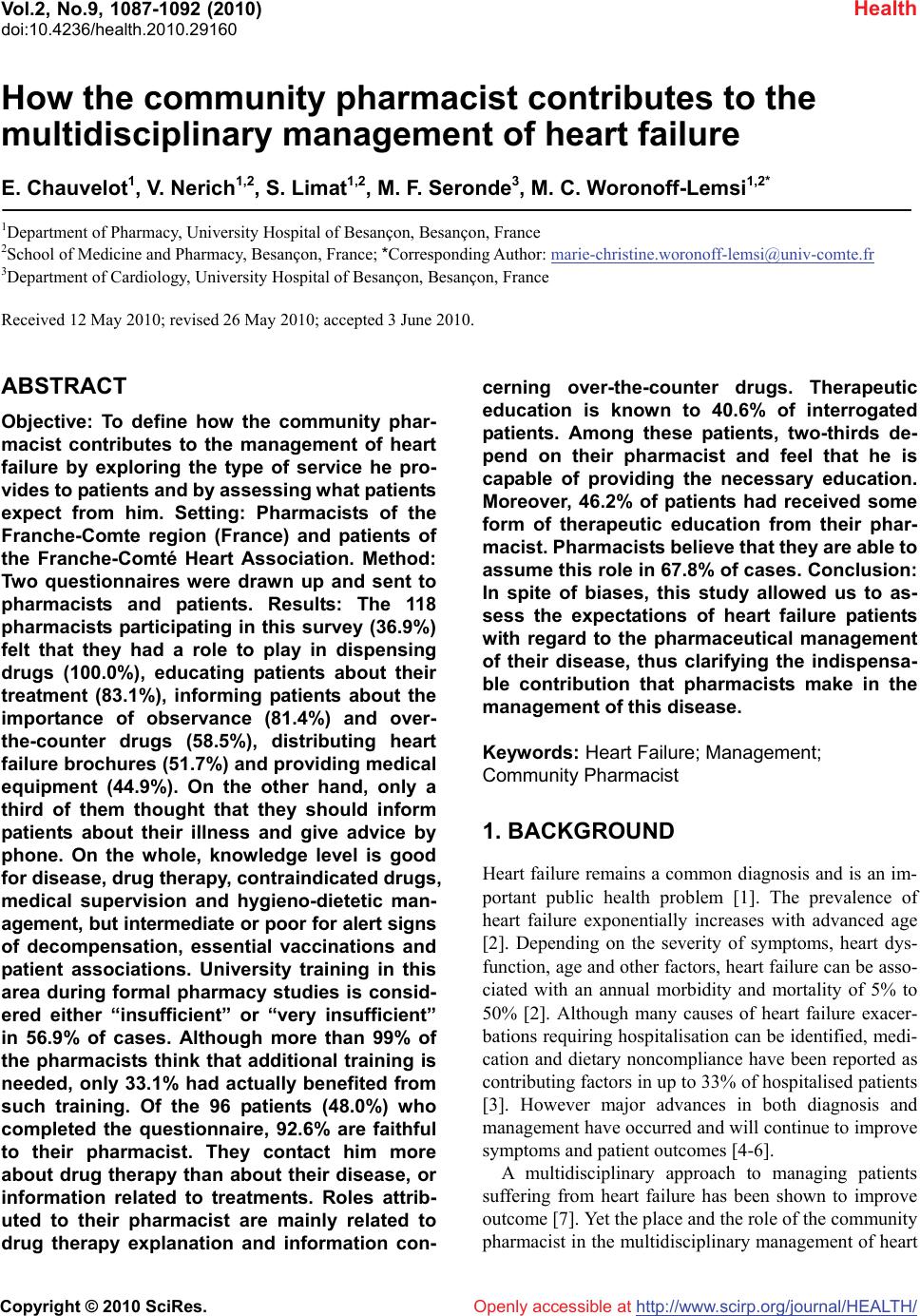 Vol.2, No.9, 1087-1092 (2010) Health doi:10.4236/health.2010.29160 Copyright © 2010 SciRes. Openly accessible at http://www.scirp.org/journal/HEALTH/ How the community pharmacist contributes to the multidisciplinary management of heart failure E. Chauvelot1, V. Nerich1,2, S. Limat1,2, M. F. Seronde3, M. C. Woronoff-Lemsi1,2* 1Department of Pharmacy, University Hospital of Besançon, Besançon, France 2School of Medicine and Pharmacy, Besançon, France; *Corresponding Author: marie-christine.woronoff-lemsi@univ-comte.fr 3Department of Cardiology, University Hospital of Besançon, Besançon, France Received 12 May 2010; revised 26 May 2010; accepted 3 June 2010. ABSTRACT Objective: To define how the community phar- macist contributes to the management of heart failure by exploring the type of service he pro- vides to patients and by assessing what patients expect from him. Setting: Pharmacists of the Franche-Comte region (France) and patients of the Franche-Comté Heart Association. Method: Two questionnaires were drawn up and sent to pharmacists and patients. Results: The 118 pharmacists participating in this survey (36.9%) felt that they had a role to play in dispensing drugs (100.0%), educating patients about their treatment (83.1%), informing patients about the importance of observance (81.4%) and over- the-counter drugs (58.5%), distributing heart failure brochures (51.7%) and providing medical equipment (44.9%). On the other hand, only a third of them thought that they should inform patients about their illness and give advice by phone. On the whole, knowledge level is good for disease, drug therapy, contraindicated drugs, medical supervision and hygieno-dietetic man- agement, but intermediate or poor for alert signs of decompensation, essential vaccinations and patient associations. University training in this area during formal pharmacy studies is consid- ered either “insufficient” or “very insufficient” in 56.9% of cases. Although more than 99% of the pharmacists think that additional training is needed, only 33.1% had actually benefited from such training. Of the 96 patients (48.0%) who completed the questionnaire, 92.6% are faithful to their pharmacist. They contact him more about drug therapy than about their disease, or information related to treatments. Roles attrib- uted to their pharmacist are mainly related to drug therapy explanation and information con- cerning over-the-counter drugs. Therapeutic education is known to 40.6% of interrogated patients. Among these patients, two-thirds de- pend on their pharmacist and feel that he is capable of providing the necessary education. Moreover, 46.2% of patients had received some form of therapeutic education from their phar- macist. Pharmacists believe that they are able to assume this role in 67.8% of cases. Conclusion: In spite of biases, this study allowed us to as- sess the expectations of heart failure patients with regard to the pharmaceutical management of their disease, thus clarifying the indispensa- ble contribution that pharmacists make in the management of this disease. Keywords: Heart Failure; Management; Community Pharmacist 1. BACKGROUND Heart failure remains a common diagnosis and is an im- portant public health problem [1]. The prevalence of heart failure exponentially increases with advanced age [2]. Depending on the severity of symptoms, heart dys- function, age and other factors, heart failure can be asso- ciated with an annual morbidity and mortality of 5% to 50% [2]. Although many causes of heart failure exacer- bations requiring hospitalisation can be identified, medi- cation and dietary noncompliance have been reported as contributing factors in up to 33% of hospitalised patients [3]. However major advances in both diagnosis and management have occurred and will continue to improve symptoms and patient outcomes [4-6]. A multidisciplinary approach to managing patients suffering from heart failure has been shown to improve outcome [7]. Yet the place and the role of the community pharmacist in the multidisciplinary management of heart 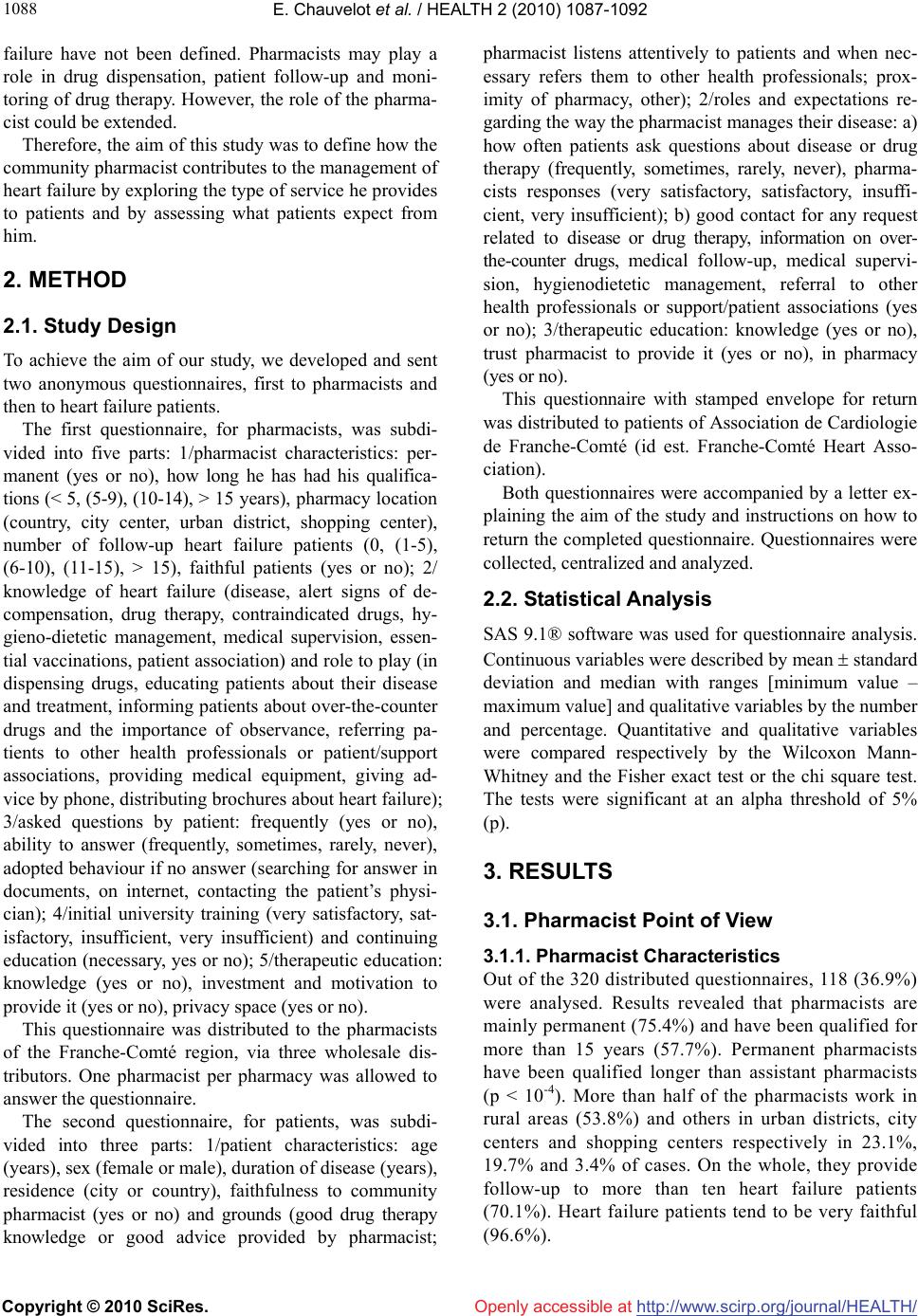 E. Chauvelot et al. / HEALTH 2 (2010) 1087-1092 Copyright © 2010 SciRes. Openly accessible at http://www.scirp.org/journal/HEALTH/ 1088 failure have not been defined. Pharmacists may play a role in drug dispensation, patient follow-up and moni- toring of drug therapy. However, the role of the pharma- cist could be extended. Therefore, the aim of this study was to define how the community pharmacist contributes to the management of heart failure by exploring the type of service he provides to patients and by assessing what patients expect from him. 2. METHOD 2.1. Study Design To achieve the aim of our study, we developed and sent two anonymous questionnaires, first to pharmacists and then to heart failure patients. The first questionnaire, for pharmacists, was subdi- vided into five parts: 1/pharmacist characteristics: per- manent (yes or no), how long he has had his qualifica- tions (< 5, (5-9), (10-14), > 15 years), pharmacy location (country, city center, urban district, shopping center), number of follow-up heart failure patients (0, (1-5), (6-10), (11-15), > 15), faithful patients (yes or no); 2/ knowledge of heart failure (disease, alert signs of de- compensation, drug therapy, contraindicated drugs, hy- gieno-dietetic management, medical supervision, essen- tial vaccinations, patient association) and role to play (in dispensing drugs, educating patients about their disease and treatment, informing patients about over-the-counter drugs and the importance of observance, referring pa- tients to other health professionals or patient/support associations, providing medical equipment, giving ad- vice by phone, distributing brochures about heart failure); 3/asked questions by patient: frequently (yes or no), ability to answer (frequently, sometimes, rarely, never), adopted behaviour if no answer (searching for answer in documents, on internet, contacting the patient’s physi- cian); 4/initial university training (very satisfactory, sat- isfactory, insufficient, very insufficient) and continuing education (necessary, yes or no); 5/therapeutic education: knowledge (yes or no), investment and motivation to provide it (yes or no), privacy space (yes or no). This questionnaire was distributed to the pharmacists of the Franche-Comté region, via three wholesale dis- tributors. One pharmacist per pharmacy was allowed to answer the questionnaire. The second questionnaire, for patients, was subdi- vided into three parts: 1/patient characteristics: age (years), sex (female or male), duration of disease (years), residence (city or country), faithfulness to community pharmacist (yes or no) and grounds (good drug therapy knowledge or good advice provided by pharmacist; pharmacist listens attentively to patients and when nec- essary refers them to other health professionals; prox- imity of pharmacy, other); 2/roles and expectations re- garding the way the pharmacist manages their disease: a) how often patients ask questions about disease or drug therapy (frequently, sometimes, rarely, never), pharma- cists responses (very satisfactory, satisfactory, insuffi- cient, very insufficient); b) good contact for any request related to disease or drug therapy, information on over- the-counter drugs, medical follow-up, medical supervi- sion, hygienodietetic management, referral to other health professionals or support/patient associations (yes or no); 3/therapeutic education: knowledge (yes or no), trust pharmacist to provide it (yes or no), in pharmacy (yes or no). This questionnaire with stamped envelope for return was distributed to patients of Association de Cardiologie de Franche-Comté (id est. Franche-Comté Heart Asso- ciation). Both questionnaires were accompanied by a letter ex- plaining the aim of the study and instructions on how to return the completed questionnaire. Questionnaires were collected, centralized and analyzed. 2.2. Statistical Analysis SAS 9.1® software was used for questionnaire analysis. Continuous variables were described by mean standard deviation and median with ranges [minimum value – maximum value] and qualitative variables by the number and percentage. Quantitative and qualitative variables were compared respectively by the Wilcoxon Mann- Whitney and the Fisher exact test or the chi square test. The tests were significant at an alpha threshold of 5% (p). 3. RESULTS 3.1. Pharmacist Point of View 3.1.1. Pharmacist Characteristics Out of the 320 distributed questionnaires, 118 (36.9%) were analysed. Results revealed that pharmacists are mainly permanent (75.4%) and have been qualified for more than 15 years (57.7%). Permanent pharmacists have been qualified longer than assistant pharmacists (p < 10-4). More than half of the pharmacists work in rural areas (53.8%) and others in urban districts, city centers and shopping centers respectively in 23.1%, 19.7% and 3.4% of cases. On the whole, they provide follow-up to more than ten heart failure patients (70.1%). Heart failure patients tend to be very faithful (96.6%).  E. Chauvelot et al. / HEALTH 2 (2010) 1087-1092 Copyright © 2010 SciRes. Openly accessible at http://www.scirp.org/journal/HEALTH/ 1089 3.1.2. Knowledge of Heart Failure and Role to Play Pharmacists’ assessment of their own knowledge of heart failure is summarized in Table 1. Their knowledge level with regard to drug therapy, hygieno-dietetics, and essential vaccinations was sig- nificantly related to the number of patient follow-ups in the pharmacy (respectively, p = 0.04, p = 0.01 and p = 0.02). Pharmacists’ knowledge level increased with the number of patients. Disease knowledge was significantly positively related to drug therapy knowledge (p < 10-3), contraindicated drugs and alert signs of decompensation knowledge (p = 0.01). Without taking into account drug dispensation (100.0%), the pharmacist plays different roles in: edu- cating patients about their treatment (83.1%), informing them about the importance of observance (81.4%) and over-the-counter drugs (58.5%), distributing brochures about heart failure (51.7%) and providing medical equipment (44.9%). One-third of the pharmacists in our study also play a role in educating patients about their disease (35.6%) and providing advice by phone (33.0%). Referral to oth- er health professionals and support/patient associations was only found for respectively 22.0% and 11.0% of pharmacists. 3.1.3. Questions Asked by Patients Pharmacists estimated that more than a third of all pa- tients (33.9%) often ask them questions. However, pharmacists were unable to answer these questions in 69.1% of cases. There is no significant difference be- tween the frequency of questions and the ability to an Table 1. Pharmacist self-evaluation: Knowledge of heart failure. Knowledge Level, number (%) n = 118 Ve ry Good Good Average Poor Disease 4 (3.4) 68 (57.6) 43 (36.4) 3 (2.5) Alert signs of decompensation 6 (5.1) 36 (30.5) 55 (46.6) 21 (17.8) Drug therapy 11 (9.3) 88 (74.6) 18 (15.3) 1 (0.9) Contraindicated drugs 11 (9.3) 59 (50.0) 42 (35.6) 6 (5.1) Medical supervision 5 (4.3) 51 (43.2) 51 (43.2) 11 (9.3) Essential vaccinations 3 (2.5) 34 (28.8) 48 (40.7) 33 (28.0) Hygieno-dietetic management 15 (12.7) 70 (59.3) 31 (26.3) 2 (1.7) Patient association 0 (0.0) 3 (2.5) 29 (24.6) 86 (72.9) swer (p = 0.69). If the pharmacist cannot answer, imme- diately, he tries to find the answer in documents (82.8%), on internet (43.1%) or by contacting the patient’s physi- cian directly (68.1%). 3.1.4. Initial University Training and Continuing Education Initial university training about heart failure was judged satisfactory to very satisfactory by 43.1% of pharmacists. More than 99% of them consider it necessary to have a additional training. However, only 33.1% of pharmacists ever actually had continuing education. The older the qualifications, the more dissatisfied the pharmacist was with his initial university training (p = 0.02) and the more interested he was in additional training (p < 10-3). Continuing education was also significantly positively related to the number of heart failure patient follow-ups in the pharmacy (p = 0.04), permanent pharmacist status (p = 0.04), and how long the pharmacists has been quali- fied (p < 10-3). 3.1.5. Therapeutic Education 77.1% of pharmacists participating in our study known about therapeutic education and they think that they are able to play this role in 67.8% of cases. More than two-thirds (70.3%) have privacy space. 3.2. Heart Failure Patient Point of View 3.2.1. Patient Characteristics Of the 200 questionnaires distributed to patients, 96 (48.0%) were collected and analysed. Patient character- istics are summarized in Table 2. The mean age of dis- ease was estimated at 8.3 0.9 years, with a median of 6 years (1-51). Patients are faithful to their pharmacist in 92.6% of cases for different grounds (Table 3). Patients living in the city are significantly more faithful than patients liv- ing in the country (p < 10-2). Listening and referral to other health professionals are significantly related to the sex of patients (p = 0.02): these roles are important for Table 2. Heart failure patient characteristics. n = 96 number (%) Sex Female Male 31 (32.3) 65 (67.7) Age classes (years) < 60 (60–75) > 75 12 (12.5) 64 (66.7) 20 (20.8) Residence* City Country 60 (63.2) 35 (36.8) Faithfulness to the pharmacy* Yes No 88 (92.6) 7 (7.4) 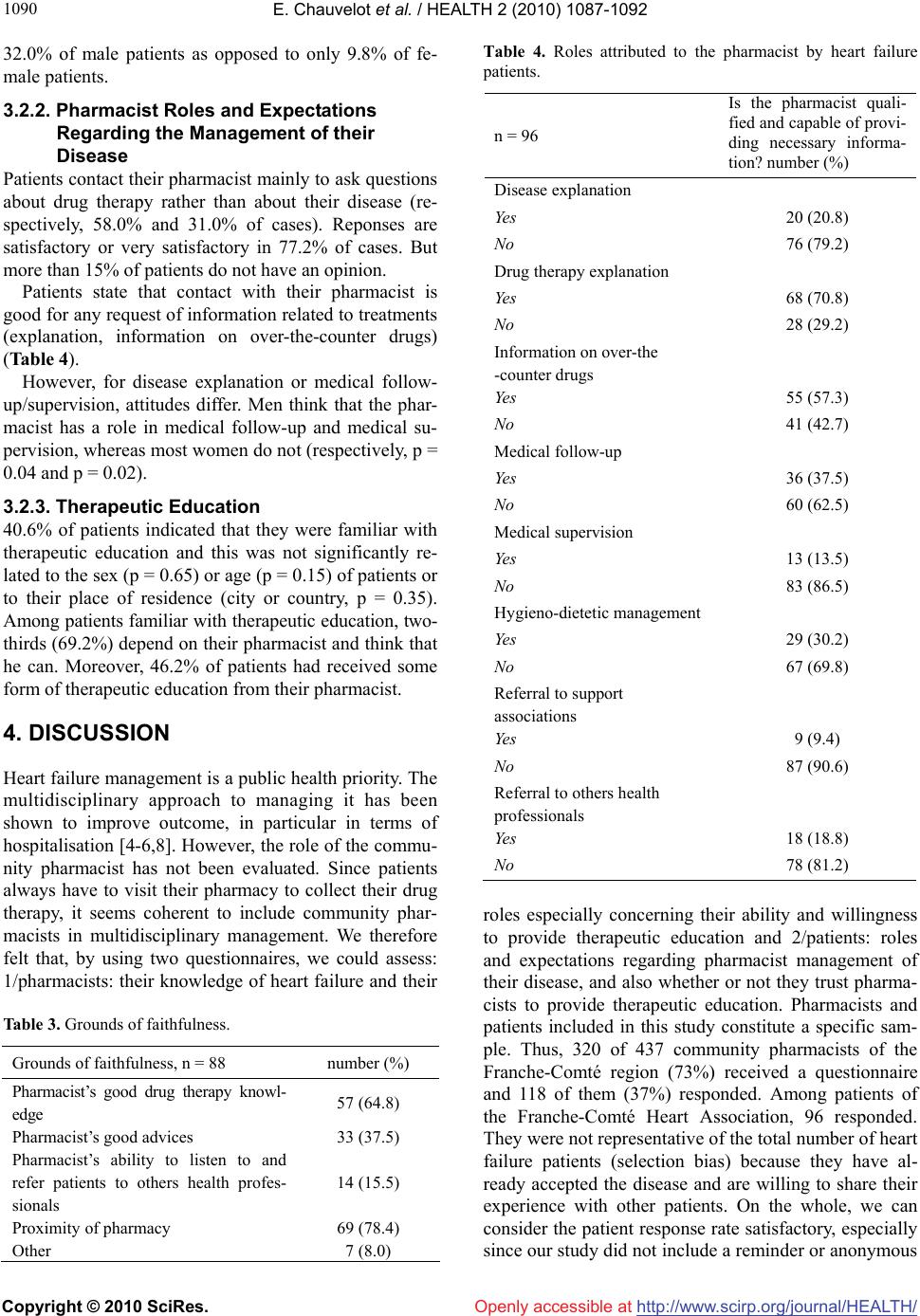 E. Chauvelot et al. / HEALTH 2 (2010) 1087-1092 Copyright © 2010 SciRes. Openly accessible at http://www.scirp.org/journal/HEALTH/ 1090 32.0% of male patients as opposed to only 9.8% of fe- male patients. 3.2.2. Pharmacist Roles and Expectations Regarding the Management of their Disease Patients contact their pharmacist mainly to ask questions about drug therapy rather than about their disease (re- spectively, 58.0% and 31.0% of cases). Reponses are satisfactory or very satisfactory in 77.2% of cases. But more than 15% of patients do not have an opinion. Patients state that contact with their pharmacist is good for any request of information related to treatments (explanation, information on over-the-counter drugs) (Table 4). However, for disease explanation or medical follow- up/supervision, attitudes differ. Men think that the phar- macist has a role in medical follow-up and medical su- pervision, whereas most women do not (respectively, p = 0.04 and p = 0.02). 3.2.3. Therapeutic Education 40.6% of patients indicated that they were familiar with therapeutic education and this was not significantly re- lated to the sex (p = 0.65) or age (p = 0.15) of patients or to their place of residence (city or country, p = 0.35). Among patients familiar with therapeutic education, two- thirds (69.2%) depend on their pharmacist and think that he can. Moreover, 46.2% of patients had received some form of therapeutic education from their pharmacist. 4. DISCUSSION Heart failure management is a public health priority. The multidisciplinary approach to managing it has been shown to improve outcome, in particular in terms of hospitalisation [4-6,8]. However, the role of the commu- nity pharmacist has not been evaluated. Since patients always have to visit their pharmacy to collect their drug therapy, it seems coherent to include community phar- macists in multidisciplinary management. We therefore felt that, by using two questionnaires, we could assess: 1/pharmacists: their knowledge of heart failure and their Table 3. Grounds of faithfulness. Grounds of faithfulness, n = 88 number (%) Pharmacist’s good drug therapy knowl- edge 57 (64.8) Pharmacist’s good advices 33 (37.5) Pharmacist’s ability to listen to and refer patients to others health profes- sionals 14 (15.5) Proximity of pharmacy 69 (78.4) Other 7 (8.0) Table 4. Roles attributed to the pharmacist by heart failure patients. n = 96 Is the pharmacist quali- fied and capable of provi- ding necessary informa- tion? number (%) Disease explanation Yes 20 (20.8) No 76 (79.2) Drug therapy explanation Yes 68 (70.8) No 28 (29.2) Information on over-the -counter drugs Yes 55 (57.3) No 41 (42.7) Medical follow-up Yes 36 (37.5) No 60 (62.5) Medical supervision Yes 13 (13.5) No 83 (86.5) Hygieno-dietetic management Yes 29 (30.2) No 67 (69.8) Referral to support associations Yes 9 (9.4) No 87 (90.6) Referral to others health professionals Yes 18 (18.8) No 78 (81.2) roles especially concerning their ability and willingness to provide therapeutic education and 2/patients: roles and expectations regarding pharmacist management of their disease, and also whether or not they trust pharma- cists to provide therapeutic education. Pharmacists and patients included in this study constitute a specific sam- ple. Thus, 320 of 437 community pharmacists of the Franche-Comté region (73%) received a questionnaire and 118 of them (37%) responded. Among patients of the Franche-Comté Heart Association, 96 responded. They were not representative of the total number of heart failure patients (selection bias) because they have al- ready accepted the disease and are willing to share their experience with other patients. On the whole, we can consider the patient response rate satisfactory, especially since our study did not include a reminder or anonymous 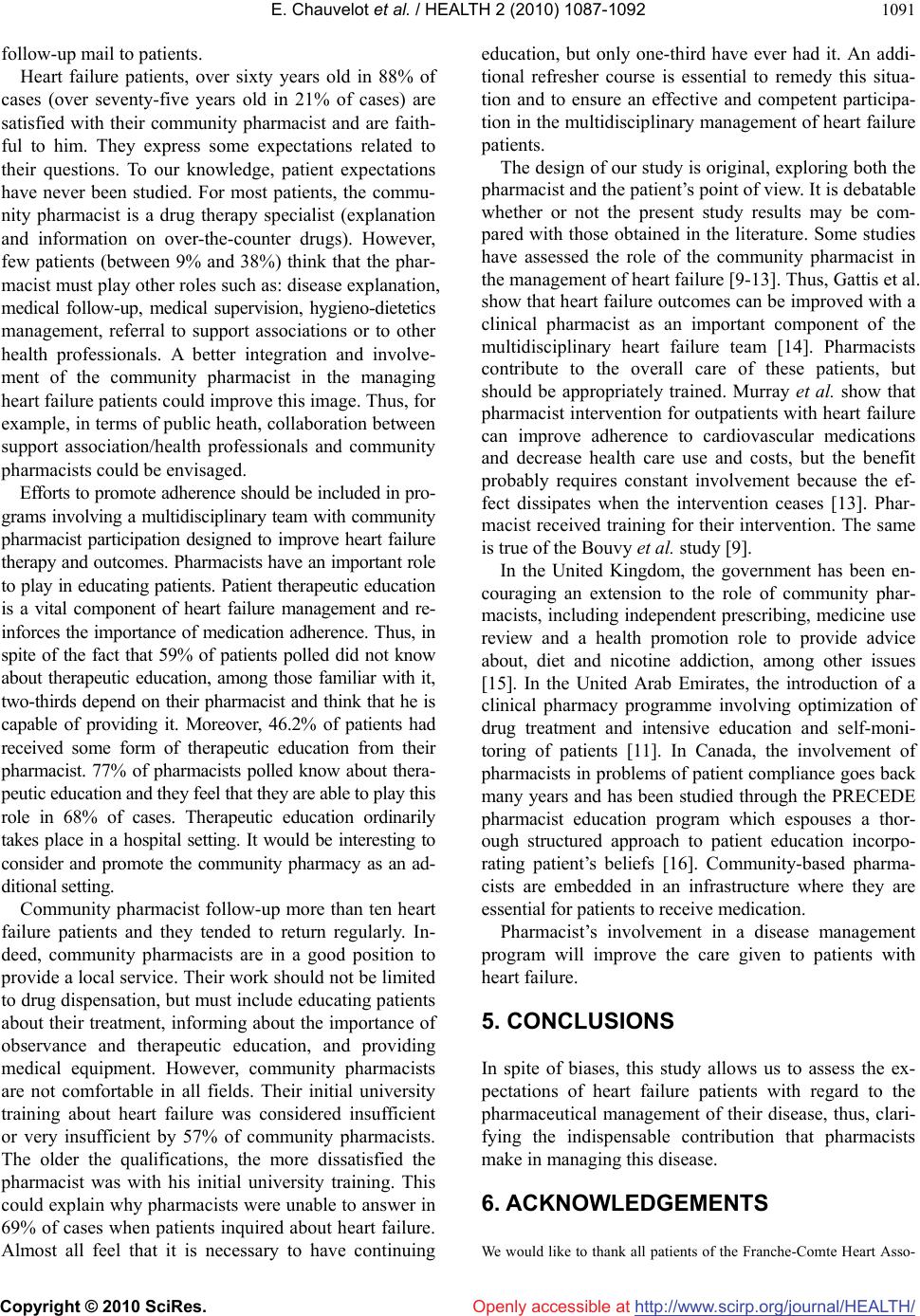 E. Chauvelot et al. / HEALTH 2 (2010) 1087-1092 Copyright © 2010 SciRes. Openly accessible at http://www.scirp.org/journal/HEALTH/ 1091 follow-up mail to patients. Heart failure patients, over sixty years old in 88% of cases (over seventy-five years old in 21% of cases) are satisfied with their community pharmacist and are faith- ful to him. They express some expectations related to their questions. To our knowledge, patient expectations have never been studied. For most patients, the commu- nity pharmacist is a drug therapy specialist (explanation and information on over-the-counter drugs). However, few patients (between 9% and 38%) think that the phar- macist must play other roles such as: disease explanation, medical follow-up, medical supervision, hygieno-dietetics management, referral to support associations or to other health professionals. A better integration and involve- ment of the community pharmacist in the managing heart failure patients could improve this image. Thus, for example, in terms of public heath, collaboration between support association/health professionals and community pharmacists could be envisaged. Efforts to promote adherence should be included in pro- grams involving a multidisciplinary team with community pharmacist participation designed to improve heart failure therapy and outcomes. Pharmacists have an important role to play in educating patients. Patient therapeutic education is a vital component of heart failure management and re- inforces the importance of medication adherence. Thus, in spite of the fact that 59% of patients polled did not know about therapeutic education, among those familiar with it, two-thirds depend on their pharmacist and think that he is capable of providing it. Moreover, 46.2% of patients had received some form of therapeutic education from their pharmacist. 77% of pharmacists polled know about thera- peutic education and they feel that they are able to play this role in 68% of cases. Therapeutic education ordinarily takes place in a hospital setting. It would be interesting to consider and promote the community pharmacy as an ad- ditional setting. Community pharmacist follow-up more than ten heart failure patients and they tended to return regularly. In- deed, community pharmacists are in a good position to provide a local service. Their work should not be limited to drug dispensation, but must include educating patients about their treatment, informing about the importance of observance and therapeutic education, and providing medical equipment. However, community pharmacists are not comfortable in all fields. Their initial university training about heart failure was considered insufficient or very insufficient by 57% of community pharmacists. The older the qualifications, the more dissatisfied the pharmacist was with his initial university training. This could explain why pharmacists were unable to answer in 69% of cases when patients inquired about heart failure. Almost all feel that it is necessary to have continuing education, but only one-third have ever had it. An addi- tional refresher course is essential to remedy this situa- tion and to ensure an effective and competent participa- tion in the multidisciplinary management of heart failure patients. The design of our study is original, exploring both the pharmacist and the patient’s point of view. It is debatable whether or not the present study results may be com- pared with those obtained in the literature. Some studies have assessed the role of the community pharmacist in the management of heart failure [9-13]. Thus, Gattis et al. show that heart failure outcomes can be improved with a clinical pharmacist as an important component of the multidisciplinary heart failure team [14]. Pharmacists contribute to the overall care of these patients, but should be appropriately trained. Murray et al. show that pharmacist intervention for outpatients with heart failure can improve adherence to cardiovascular medications and decrease health care use and costs, but the benefit probably requires constant involvement because the ef- fect dissipates when the intervention ceases [13]. Phar- macist received training for their intervention. The same is true of the Bouvy et al. study [9]. In the United Kingdom, the government has been en- couraging an extension to the role of community phar- macists, including independent prescribing, medicine use review and a health promotion role to provide advice about, diet and nicotine addiction, among other issues [15]. In the United Arab Emirates, the introduction of a clinical pharmacy programme involving optimization of drug treatment and intensive education and self-moni- toring of patients [11]. In Canada, the involvement of pharmacists in problems of patient compliance goes back many years and has been studied through the PRECEDE pharmacist education program which espouses a thor- ough structured approach to patient education incorpo- rating patient’s beliefs [16]. Community-based pharma- cists are embedded in an infrastructure where they are essential for patients to receive medication. Pharmacist’s involvement in a disease management program will improve the care given to patients with heart failure. 5. CONCLUSIONS In spite of biases, this study allows us to assess the ex- pectations of heart failure patients with regard to the pharmaceutical management of their disease, thus, clari- fying the indispensable contribution that pharmacists make in managing this disease. 6. ACKNOWLEDGEMENTS We would like to thank all patients of the Franche-Comte Heart Asso- 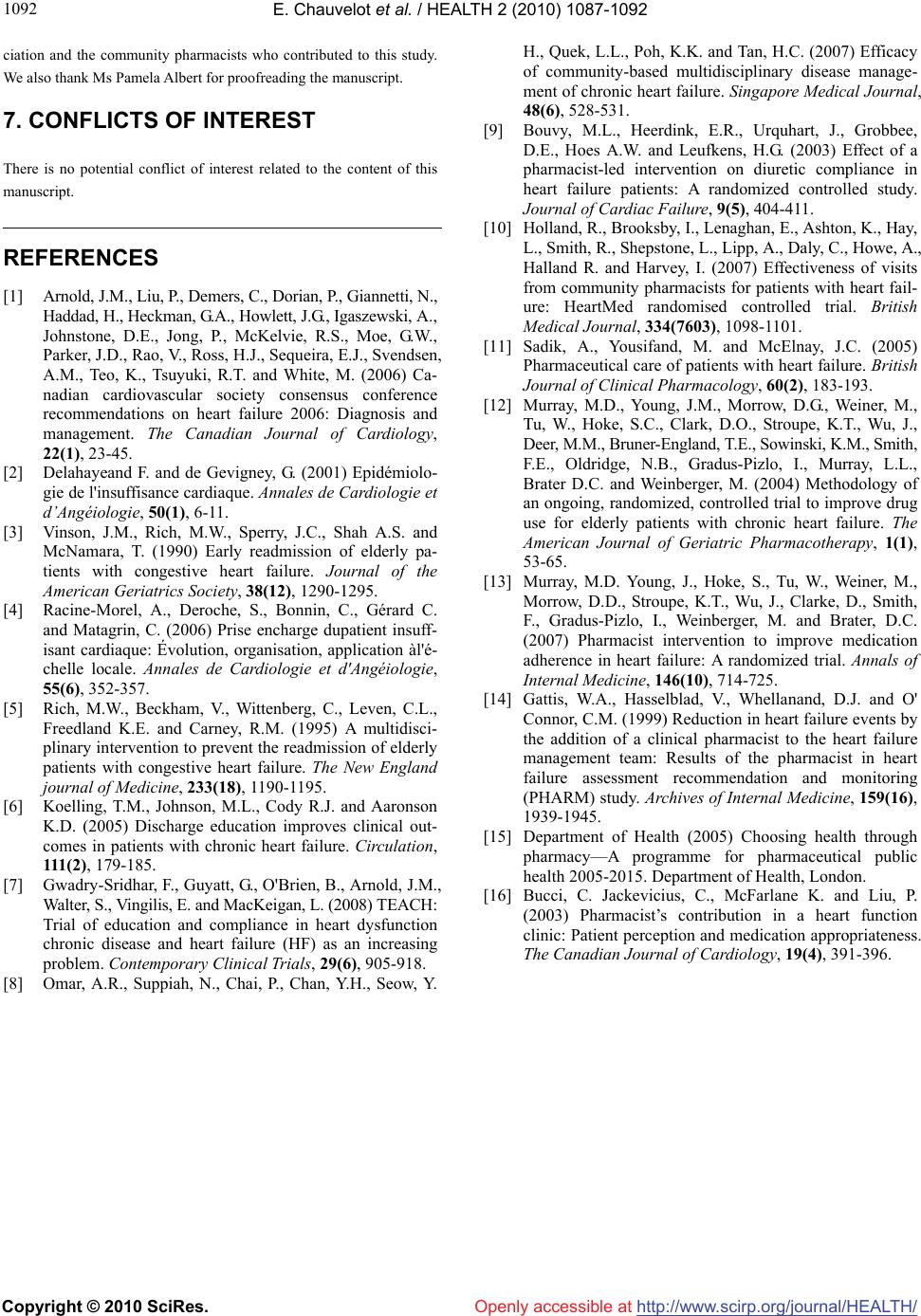 E. Chauvelot et al. / HEALTH 2 (2010) 1087-1092 Copyright © 2010 SciRes. Openly accessible at http://www.scirp.org/journal/HEALTH/ 1092 ciation and the community pharmacists who contributed to this study. We also thank Ms Pamela Albert for proofreading the manuscript. 7. CONFLICTS OF INTEREST There is no potential conflict of interest related to the content of this manuscript. REFERENCES [1] Arnold, J.M., Liu, P., Demers, C., Dorian, P., Giannetti, N., Haddad, H., Heckman, G.A., Howlett, J.G., Igaszewski, A., Johnstone, D.E., Jong, P., McKelvie, R.S., Moe, G.W., Parker, J.D., Rao, V., Ross, H.J., Sequeira, E.J., Svendsen, A.M., Teo, K., Tsuyuki, R.T. and White, M. (2006) Ca- nadian cardiovascular society consensus conference recommendations on heart failure 2006: Diagnosis and management. The Canadian Journal of Cardiology, 22(1), 23-45. [2] Delahayeand F. and de Gevigney, G. (2001) Epidémiolo- gie de l'insuffisance cardiaque. Annales de Cardiologie et d’Angéiologie, 50(1), 6-11. [3] Vinson, J.M., Rich, M.W., Sperry, J.C., Shah A.S. and McNamara, T. (1990) Early readmission of elderly pa- tients with congestive heart failure. Journal of the American Geriatrics Society, 38(12), 1290-1295. [4] Racine-Morel, A., Deroche, S., Bonnin, C., Gérard C. and Matagrin, C. (2006) Prise encharge dupatient insuff- isant cardiaque: Évolution, organisation, application àl'é- chelle locale. Annales de Cardiologie et d'Angéiologie, 55(6), 352-357. [5] Rich, M.W., Beckham, V., Wittenberg, C., Leven, C.L., Freedland K.E. and Carney, R.M. (1995) A multidisci- plinary intervention to prevent the readmission of elderly patients with congestive heart failure. The New England journal of Medicine, 233(18), 1190-1195. [6] Koelling, T.M., Johnson, M.L., Cody R.J. and Aaronson K.D. (2005) Discharge education improves clinical out- comes in patients with chronic heart failure. Circulation, 111(2), 179-185. [7] Gwadry-Sridhar, F., Guyatt, G., O'Brien, B., Arnold, J.M., Walter, S., Vingilis, E. and MacKeigan, L. (2008) TEACH: Trial of education and compliance in heart dysfunction chronic disease and heart failure (HF) as an increasing problem. Contemporary Clinical Trials, 29(6), 905-918. [8] Omar, A.R., Suppiah, N., Chai, P., Chan, Y.H., Seow, Y. H., Quek, L.L., Poh, K.K. and Tan, H.C. (2007) Efficacy of community-based multidisciplinary disease manage- ment of chronic heart failure. Singapore Medical Journal, 48(6), 528-531. [9] Bouvy, M.L., Heerdink, E.R., Urquhart, J., Grobbee, D.E., Hoes A.W. and Leufkens, H.G. (2003) Effect of a pharmacist-led intervention on diuretic compliance in heart failure patients: A randomized controlled study. Journal of Cardiac Failure, 9(5), 404-411. [10] Holland, R., Brooksby, I., Lenaghan, E., Ashton, K., Hay, L., Smith, R., Shepstone, L., Lipp, A., Daly, C., Howe, A., Halland R. and Harvey, I. (2007) Effectiveness of visits from community pharmacists for patients with heart fail- ure: HeartMed randomised controlled trial. British Medical Journal, 334(7603), 1098-1101. [11] Sadik, A., Yousifand, M. and McElnay, J.C. (2005) Pharmaceutical care of patients with heart failure. British Journal of Clinical Pharmacology, 60(2), 183-193. [12] Murray, M.D., Young, J.M., Morrow, D.G., Weiner, M., Tu, W., Hoke, S.C., Clark, D.O., Stroupe, K.T., Wu, J., Deer, M.M., Bruner-England, T.E., Sowinski, K.M., Smith, F.E., Oldridge, N.B., Gradus-Pizlo, I., Murray, L.L., Brater D.C. and Weinberger, M. (2004) Methodology of an ongoing, randomized, controlled trial to improve drug use for elderly patients with chronic heart failure. The American Journal of Geriatric Pharmacotherapy, 1(1), 53-65. [13] Murray, M.D. Young, J., Hoke, S., Tu, W., Weiner, M., Morrow, D.D., Stroupe, K.T., Wu, J., Clarke, D., Smith, F., Gradus-Pizlo, I., Weinberger, M. and Brater, D.C. (2007) Pharmacist intervention to improve medication adherence in heart failure: A randomized trial. Annals of Internal Medicine, 146(10), 714-725. [14] Gattis, W.A., Hasselblad, V., Whellanand, D.J. and O' Connor, C.M. (1999) Reduction in heart failure events by the addition of a clinical pharmacist to the heart failure management team: Results of the pharmacist in heart failure assessment recommendation and monitoring (PHARM) study. Archives of Internal Medicine, 159(16), 1939-1945. [15] Department of Health (2005) Choosing health through pharmacy—A programme for pharmaceutical public health 2005-2015. Department of Health, London. [16] Bucci, C. Jackevicius, C., McFarlane K. and Liu, P. (2003) Pharmacist’s contribution in a heart function clinic: Patient perception and medication appropriateness. The Canadian Journal of Cardiology, 19(4), 391-396. |

